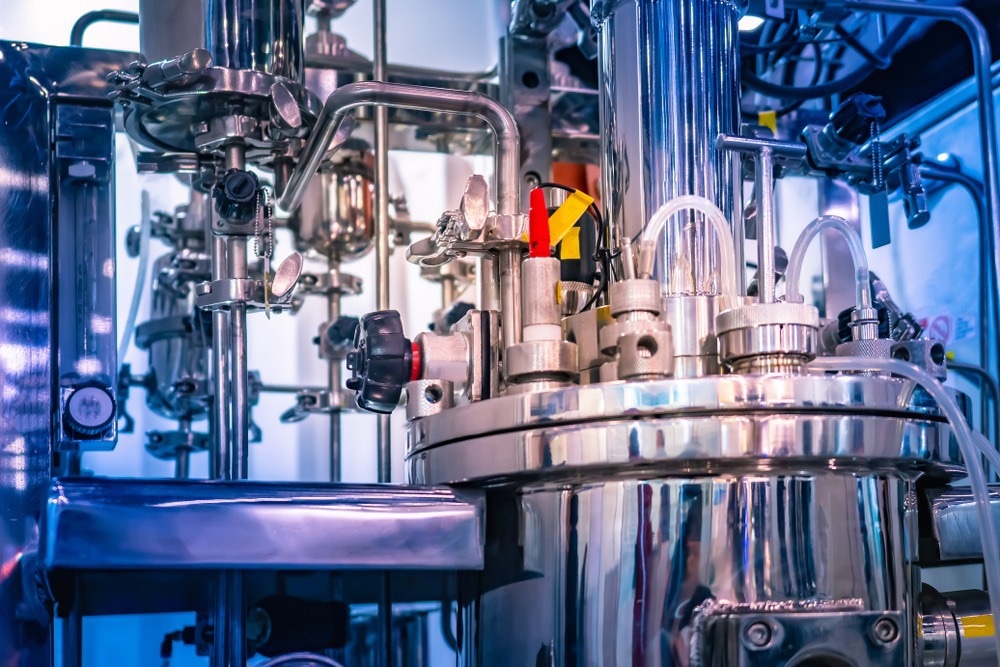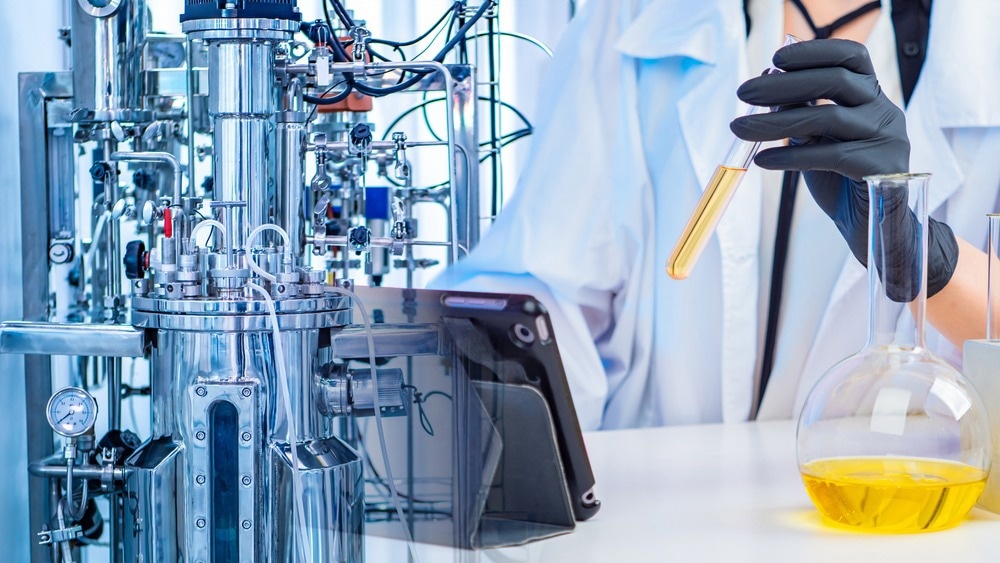Fermentation is the chemical process by which carbohydrates are broken down to produce energy, which microorganisms often engage in as part of their natural metabolic process using enzymes. Bacteria, fungi, and some eukaryotic cells are utilized in industry to produce fermented products such as ethanol, as well as secondary metabolite products of fermentation, such as penicillin.

Image Credit: FOTOGRIN/Shutterstock.com
Fermentation may be carried out using a purified batch of enzymes that are known to engage in hydrolysis of the substrate sugar utilized, often extracted from plant or animal sources. In some processes, this may be preferred as it can be ensured that no contaminants are present. However, industrial fermentation using microbes that naturally bear the required enzymes presents several advantages in terms of cost efficiency and scalable complexity. Microorganisms may be used directly in fermentation, sharing the same reaction vessel with the carbohydrate raw material, or may be used as a source of purified enzymes that engage in fermentation, to be used later in a batch process.
Optimizing Fermentation Conditions
Industrial fermentation is performed in water- and oxygen-rich environments. Conditions such as temperature and pH are carefully controlled to optimize the growth of the microorganism employed, encourage the hydrolysis of carbohydrates by maximizing the activity of the enzyme, and remain suitable for the product being produced.
Fermentation is an exothermic process and thus generates heat, which can take the microorganisms and their relevant enzymes beyond ideal conditions, causing protein denaturation and cell death. Several warming and cooling processes are utilized to control temperature directly during industrial fermentation. However, significant effort has been put into developing hardier strains of microorganisms that can tolerate fluctuations and extremes of condition.
Similarly, microorganisms are constantly selected and engineered to express favorable properties such as resistance to phages, optimized metabolic rate, increased production of relevant enzymes, and improved yield. Mixed co-cultures of differing microorganisms are sometimes employed to engage in fermentation in a synergistic manner, for example, co-cultures of S. cerevisiae (Brewer’s yeast), Torulaspora delbrueckii (a yeast commonly used in winemaking), and Pichia anómala (a fungi) can be used in the production of bread. Bread prepared by this co-culture produced a favorable aroma and color properties with a high abundance and variety of volatile organic compounds.
The carbohydrate raw material undergoing fermentation may also be prepared and optimized for interaction with the enzymes. Physical techniques such as grinding ensure that the material offers a high surface area for the access of microorganisms. In contrast, chemical techniques include water pretreatment, substrate preparation, or enzymatic hydrolysis.
Utilizing Microorganisms for Enzyme Production
Genetically modified (GM) microorganisms can produce improved product yields and fewer unwanted secondary metabolites than wild-type microorganisms by optimizing enzyme production and the possibility of enzyme modification to enhance substrate affinity. The recombinant production of proteins by GM organisms has allowed the mass production of novel and otherwise impossible-to-obtain enzymes to be utilized in fermentation.
A host organism with favorable culture characteristics, growth, and enzyme production can be selected to express enzymes originating from other organisms, which are subsequently collected and purified. In this way, secondary metabolite natural drug products or precursors can be generated, and proteins from pathogenic organisms can be safely gathered in large quantities.
E.coli are the most popular choice of host bacterium thanks to their ease of culturing, handling, and genetic manipulation, and enzymes produced by recombinant E.coli are used to catalyze specific fermentation reactions in industrial processes. Disadvantages of bacterial systems include the production of endotoxins and the need for extensive purification processes. Yeast, in particular, is commonly used in industrial fermentation processes.

Image Credit: FOTOGRIN/Shutterstock.com
Early GM yeast was developed prior to the 1980’s, with P. pastoris created as a recombinant expression vector of alcohol oxidase. P. pastoris grows in extremely high density in fermentation culture, generating a large quantity of the desired protein, and in the 1990’s was made to recombinantly express the fermenting enzyme hydroxynitrile lyase, used in organic chemistry to perform a number of reactions such as hydrolysis, cyclization, nucleophilic addition, or nucleophilic substitution.
A large proportion of microorganisms utilized in industrial fermentation produce the necessary enzymes extracellularly, which can thus be easily separated and purified by centrifugation if required. When using microorganisms that produce the desired enzyme intracellularly, the cell membrane must be broken by enzymes or mechanical means to collect and purify the enzyme.
Sources
Adebo et al. (2018) Advances in Fermentation Technology for Novel Food Products. Innovations in Technologies for Fermented Food and Beverage Industries. Available at:
https://link.springer.com/chapter/10.1007/978-3-319-74820-7_4
Wahyono et al. (2016) Improving Bread Quality Using Co-cultures of Saccharomyces cerevisiae, Torulaspora delbrueckii JK08, and Pichia anomala JK04. Italian journal of food science. Available at: https://www.itjfs.com/index.php/ijfs/article/view/147
Deckers et al. (2020) Genetically Modified Microorganisms for Industrial Food Enzyme Production: An Overview. Foods. Available at: https://www.mdpi.com/2304-8158/9/3/326/pdf
Neubauer & Winter (2001) Expression and Fermentation Strategies for Recombinant Protein Production in Escherichia Coli. Recombinant Protein Production with Prokaryotic and Eukaryotic Cells. A Comparative View on Host Physiology. Available at: https://link.springer.com/chapter/10.1007/978-94-015-9749-4_17
Purkarthofer et al. (2007) Potential and capabilities of hydroxynitrile lyases as biocatalysts in the chemical industry. Applied microbiology and biotechnology. Available at: https://link.springer.com/article/10.1007/s00253-007-1025-6
Further Reading
Last Updated: Sep 26, 2023